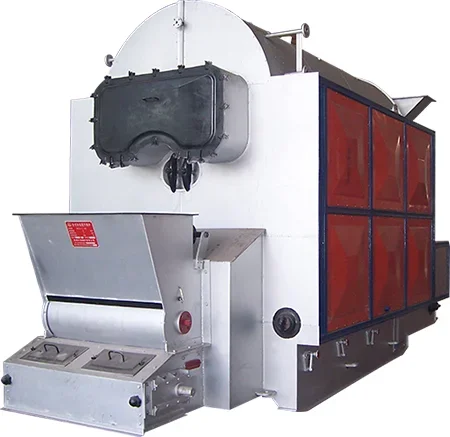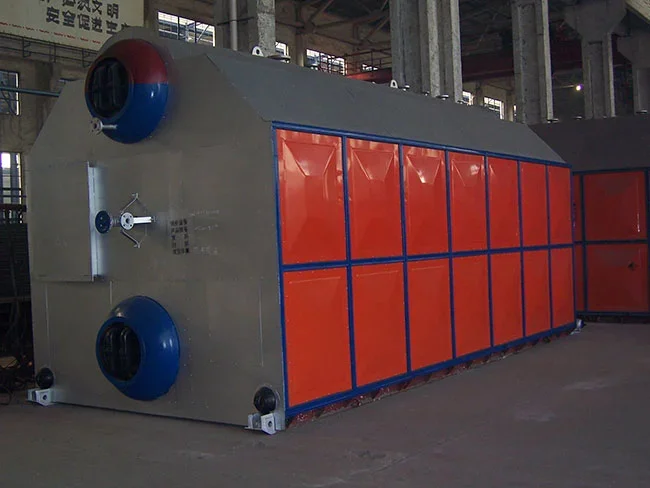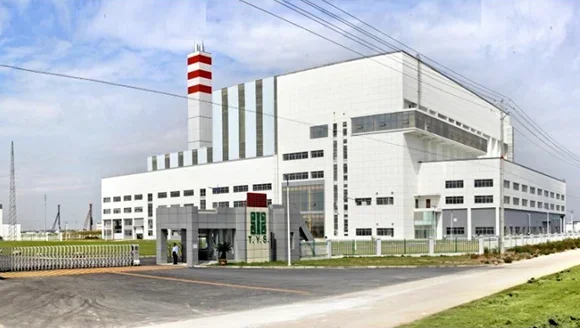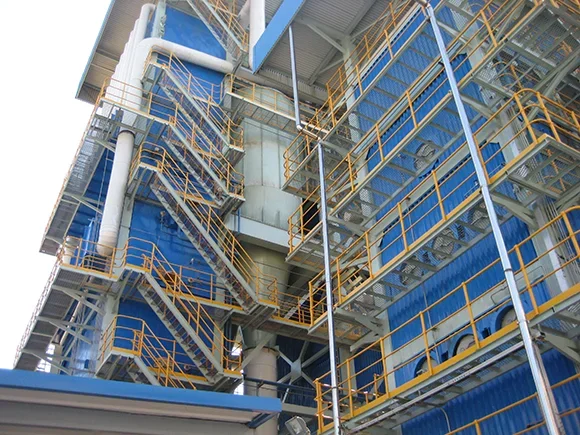-
Efficient Heat Generation and Improved Combustion Efficiency
In the realm of energy production, coal-fired boilers play a pivotal role. These robust systems efficiently generate heat by burning coal, a traditional energy source. Despite their effectiveness, concerns about environmental impact and sustainability have emerged. This blog post delves into the intricacies of coal-fired boilers, exploring their operation, benefits, and the ongoing shift towards cleaner alternatives. By understanding the nuances of these boilers and the challenges they pose, stakeholders can make informed decisions regarding energy production and environmental stewardship.
Understanding Coal-Fired Boilers
Functionality
Coal-fired boilers are used to generate heat or electricity by burning coal. The process involves heating water to create steam, which then drives turbines to produce power. These boilers are commonly found in industrial settings like power plants and manufacturing facilities.
Coal is burned inside the boiler at high temperatures. This combustion releases energy that heats the water circulating through the boiler's tubes. As the water turns into steam, it builds pressure, which is harnessed to generate electricity or provide heat for various applications.
Types of Coal
Different types of coal can be used in coal-fired boilers, such as anthracite, bituminous, sub-bituminous, and lignite. Anthracite is a high-quality coal with high carbon content and low moisture levels, making it efficient for energy production. On the other hand, lignite has lower carbon content but higher moisture levels compared to anthracite.
-
Pros:
-
Efficient energy production
-
Versatile application in various industries
-
Maintenance
Regular maintenance of coal-fired boilers is crucial for optimal performance and safety. This includes cleaning ash buildup from the combustion chamber, inspecting and repairing any leaks in the boiler system, and ensuring proper ventilation for safe operation.
Proper maintenance helps prevent issues like corrosion, overheating, or inefficient fuel combustion that can lead to breakdowns or safety hazards. It also extends the lifespan of the boiler and ensures consistent performance over time.
Types of Coal-Fired Boilers
Stoker Boilers
Stoker boilers are one of the oldest types of coal-fired boilers. They use a mechanical system to distribute coal into the combustion chamber. The fuel is then burned on a grate, allowing for efficient and controlled combustion. Stoker boilers are known for their reliability and ability to burn various types of coal, making them versatile in different applications.
Stoker Boilers:
-
Reliable operation
-
Versatile fuel options
Stoker boilers have been widely used in industrial settings like power plants due to their efficiency and adaptability to different coal types.
Pulverized Coal Boilers
Pulverized coal boilers crush the coal into fine particles before it is injected into the boiler furnace. This method allows for complete combustion as the finely ground coal mixes with air in the combustion chamber. These boilers are highly efficient and produce lower emissions compared to other types, making them environmentally friendly options for many industries.
Pulverized Coal Boilers:
-
High efficiency
-
Lower emissions
Industries looking to reduce their carbon footprint often opt for pulverized coal boilers because they offer both efficiency and environmental benefits.
Fluidized Bed Combustion Boilers
Fluidized bed combustion boilers suspend coal particles in an upward flow of combustion air within a bed of limestone or sand. This process creates a turbulent mix that promotes thorough mixing and chemical reactions during combustion. Fluidized bed combustion technology allows for flexibility in fuel choices, including low-quality coals or biomass fuels.
Fluidized Bed Combustion Boilers:
-
Fuel flexibility
-
Efficient mixing during combustion
Power plants seeking versatility in fuel sources often choose fluidized bed combustion boilers due to their ability to burn various materials efficiently.

Working Principle of Coal-Fired Boilers
Combustion Process
Coal-fired boilers operate by burning coal to generate heat. The combustion process involves the ignition of coal in the furnace, producing hot gases that travel through tubes surrounded by water. As the water absorbs heat, it turns into steam under high pressure.
The combustion process is critical for generating heat in coal-fired boilers. It begins with coal being ignited in the furnace, creating a fireball that heats up the boiler's tubes. These tubes are filled with water which turns into steam as it absorbs heat from the hot gases produced during combustion.
Steam Generation and Distribution
Once steam is produced in a coal-fired boiler, it needs to be distributed efficiently for various applications. The generated steam travels through pipes under high pressure to reach different parts of a facility where it can be utilized for heating or powering machinery. Proper distribution ensures optimal use of the generated steam.
In a coal-fired boiler, after steam is created through the combustion process, it moves through pipes at high pressure to reach different areas where its energy can be harnessed effectively. This distribution system ensures that the steam reaches its intended destination within a facility for heating or mechanical work.
Advantages of Coal-Fired Boilers
Cost-Effective
Coal-fired boilers are known for being cost-effective due to the abundance and affordability of coal as a fuel source. This makes them an attractive option for industries looking to keep operational costs low. Compared to other fuel types, such as natural gas or oil, coal is often more budget-friendly.
Coal-fired boilers require less maintenance than other types of boilers, leading to lower maintenance costs over time. The simplicity of the design and the availability of spare parts contribute to cost savings for businesses that rely on these boilers for their operations.
Energy Efficiency
One significant advantage of coal-fired boilers is their energy efficiency. These boilers have high thermal efficiency levels, meaning they can effectively convert coal into heat energy with minimal waste. This efficiency results in better performance and lower energy bills for users.
The steady and consistent heat output provided by coal-fired boilers is another key benefit, especially for industrial processes that require a constant source of heat. This reliability ensures smooth operations without fluctuations in temperature, enhancing productivity.

Applications of Coal-Fired Boilers
Industrial Use
Coal-fired boilers are commonly used in various industries for generating heat or steam. Industries such as power generation, steel production, and chemical processing rely on coal-fired boilers to meet their energy needs efficiently.
Industries benefit from the high thermal efficiency of coal-fired boilers, making them cost-effective for large-scale operations. The ability to produce high-pressure steam quickly is crucial for industrial processes like electricity generation and manufacturing.
Residential Heating
In addition to industrial applications, coal-fired boilers are also utilized in residential settings for heating purposes. In areas where coal is abundant and affordable, households may use coal-fired boilers as a primary source of heat during colder months.
Residential users appreciate the consistent and reliable heat output provided by coal-fired boilers. They offer a viable heating solution that can be more economical than other fuel sources in certain regions.
Environmental Impact and Low Carbon Emission Features
Advanced Combustion Technologies
Eco-friendly coal-fired boilers incorporate advanced combustion technologies that efficiently burn coal, resulting in lower carbon emissions. By optimizing the combustion process, these boilers produce fewer pollutants, such as carbon dioxide and sulfur dioxide. This technology helps reduce the environmental impact associated with traditional coal combustion methods.
These advanced coal-fired boilers are designed to operate at high efficiency levels, ensuring that more energy is extracted from each unit of coal burnt. As a result, they require less coal to generate the same amount of heat or electricity compared to older boiler models. This increased efficiency not only reduces carbon emissions but also conserves coal resources for future use.
-
More efficient combustion process
-
Lower carbon emissions
-
Reduced pollutants like sulfur dioxide
Mitigating Air Pollution and Climate Change Effects
The adoption of eco-friendly coal-fired boilers plays a crucial role in reducing air pollution by minimizing harmful emissions into the atmosphere. These boilers are equipped with emission control systems that capture pollutants before they are released into the air. By implementing stringent emission standards, these boilers help maintain clean air quality in their surroundings.
Moreover, by utilizing low-carbon technologies in coal-fired boilers, industries can significantly contribute to mitigating climate change effects caused by greenhouse gas emissions. The reduction in carbon output from these boilers aids in lowering the overall carbon footprint of industrial operations, aligning with global efforts to combat climate change.
-
Minimized harmful emissions
-
Enhanced air quality control measures
-
Contribution to combating climate change
Cleaner and Greener Environment Promotion
The use of eco-friendly coal-fired boilers promotes a cleaner and greener environment by fostering sustainable industrial practices. Industries that adopt these environmentally conscious technologies demonstrate their commitment to reducing their ecological footprint while meeting energy demands efficiently. Showcasing environmental responsibility through eco-friendly initiatives enhances corporate sustainability profiles.
By transitioning towards eco-friendly energy solutions like advanced coal-fired boilers, industries actively participate in creating a more sustainable future for generations to come. The shift towards cleaner energy sources not only benefits the environment but also sets a precedent for responsible resource management within industrial sectors.
-
Sustainable industrial practices promotion
-
Corporate sustainability enhancement
-
Responsible resource management exemplification

Efficient Heat Generation and Improved Combustion Efficiency
Optimized Combustion Processes
Coal-fired boilers are designed to ensure efficient heat generation by optimizing their combustion processes. By carefully controlling the air and fuel mixture, these boilers can achieve maximum efficiency in converting coal into heat energy. This optimization not only increases the overall performance of the boiler but also reduces harmful emissions, contributing to a cleaner environment.
-
Efficient heat generation
-
Controlled air and fuel mixture for optimization
Advanced technologies like flue gas desulfurization play a crucial role in enhancing the combustion efficiency of coal-fired boilers. Through this process, sulfur dioxide emissions are significantly reduced, minimizing environmental impact while improving the overall operation of the boiler. By integrating such technologies, coal-fired boilers can operate more effectively and sustainably.
-
Flue gas desulfurization technology
-
Reduction of sulfur dioxide emissions
Higher Energy Output and Reduced Fuel Consumption
The improved combustion efficiency achieved through eco-friendly coal-fired boilers results in higher energy output with reduced fuel consumption. This means that these boilers can generate more heat using less coal compared to traditional models. As a result, businesses or households utilizing coal-fired boilers experience cost savings due to lower fuel requirements while benefiting from increased thermal efficiency.
-
Higher energy output
-
Reduced fuel consumption for cost savings
Integration of Green Technologies in Coal-Fired Boilers
Benefits of Green Technology Integration
Coal-fired boilers can be made more eco-friendly by integrating green technologies like biomass co-firing. This integration is beneficial as it helps in further reducing emissions and diversifying fuel sources. By combining coal with renewable energy sources, a more sustainable energy mix is promoted.
Integrating green technologies into coal-fired boilers offers several advantages. Firstly, it reduces the environmental impact by lowering harmful emissions such as sulfur dioxide and nitrogen oxides. Secondly, it enhances the overall efficiency of the boiler system, leading to better heat generation and combustion efficiency. Lastly, this integration helps in utilizing alternative fuel sources like biomass alongside coal.
-
Pros:
-
Reduced harmful emissions
-
Enhanced boiler efficiency
-
Utilization of alternative fuel sources
-
Examples of Green Technology Integration
One common method of integrating green technologies into coal-fired boilers is through biomass co-firing. Biomass materials such as wood pellets or agricultural residues are mixed with coal during combustion to reduce greenhouse gas emissions and enhance sustainability. Another example is the use of flue gas desulfurization systems that help in removing sulfur dioxide from boiler exhaust gases.
-
Examples:
-
Biomass co-firing
-
Flue gas desulfurization systems
-
Integrating green technologies into coal-fired boilers not only benefits the environment but also contributes to a more diverse and resilient energy sector. Companies investing in these advancements are paving the way for a greener future while maintaining reliable energy production from coal.

Closing Thoughts
The exploration of coal-fired boilers has revealed their diverse types, working principles, advantages, applications, environmental impacts, and integration of green technologies. These boilers stand as a crucial component in various industries for efficient heat generation and improved combustion efficiency. Despite their benefits, the environmental concerns surrounding coal-fired boilers necessitate a shift towards sustainable practices and the adoption of low carbon emission features. The integration of green technologies presents a promising avenue to mitigate the environmental impact while maintaining operational efficiency.
As industries navigate the balance between energy needs and environmental responsibility, embracing advancements in clean energy technologies becomes imperative. Stakeholders are encouraged to prioritize sustainability by investing in research and development for innovative solutions that align with global environmental goals. By fostering a collaborative approach towards greener alternatives, the future of energy production can harmonize economic growth with ecological preservation.
Frequently Asked Questions
What are the main types of coal-fired boilers?
There are mainly three types of coal-fired boilers: pulverized coal, cyclone furnace, and fluidized bed boilers. Each type has its unique combustion method and efficiency levels.
How do coal-fired boilers contribute to efficient heat generation?
Coal-fired boilers achieve efficient heat generation by burning coal to produce steam that can be used for various applications such as electricity generation or industrial processes.
What are the environmental impacts associated with coal-fired boilers?
Coal-fired boilers have environmental impacts due to emissions of pollutants like sulfur dioxide, nitrogen oxides, and particulate matter. However, modern technologies aim to reduce these emissions through advanced control systems.
Can green technologies be integrated into coal-fired boilers?
Yes, green technologies can be integrated into coal-fired boilers to enhance their efficiency and reduce environmental impact. Examples include using biomass co-firing or installing carbon capture and storage systems.
What are the key advantages of using coal-fired boilers?
The key advantages of using coal-fired boilers include cost-effectiveness, reliability in power generation, high thermal efficiency, and the ability to provide consistent heat output for various industrial processes.
